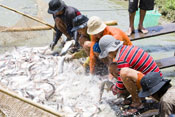Pangasius and Bivalve Global Standards CompletedGENERAL
- Two sets of global standards - one for pangasius farming and the
other for bivalve farming - have been finalised by the Aquaculture
Dialogues. They were
developed over the past three years by 1,000 farmers, scientists,
conservationists and others with a shared vision of minimising the
negative impact pangasius or bivalve farming can have on the
environment, farm workers and surrounding communities.
Most of the pangasius and bivalves consumed worldwide are produced on a
farm. Industries for both species are growing rapidly. Pangasius is one
of the top sellers in Europe's white fish market.
More than 600 participants make up the Pangasius Aquaculture Dialogue,
responsible for developing the pangasius standards, while the standards
for clams, mussels, oysters and scallops are a product of the 400-person
Bivalve Aquaculture Dialogue. These comprise two of the eight
aquaculture roundtables coordinated by World Wildlife Fund (WWF). The
first set of Dialogue standards - for tilapia - was finalised in 2009.
"This is a huge milestone for the Aquaculture Dialogues," said WWF-US Aquaculture Program Managing Director Jose Villalon.
"The timing could not be better. With the aquaculture industry growing
so quickly, there is a tremendous need for standards that are created
through a credible process - one that is open, transparent and based on
sound science."
"As a major European fish brand, it is important for our business to
know that there are standards that were created through a very credible
process and will be independently audited," said David Graham of Birds
Eye Iglo Group, who is a member of the pangasius Dialogue's Process
Facilitation Group. "That's what we need in order to help enhance
consumer confidence in what is still a relatively unfamiliar fish
species."
The final standards, which will help address such issues as improper use
of chemicals, water pollution and poor working conditions, are focused
solely on the key impacts of aquaculture. This approach results in a
manageable list of standards, instead of an exhaustive list that may
increase the cost of certification and would be harder for small-scale
farmers to adopt.
Both Dialogues integrated feedback from more than 400 people during two
public comment periods, as well as input provided during Dialogue
meetings, to develop the final standards. Also, outreach meetings were
held with small-scale pangasius farmers, agriculture farmers and farm
employees in Vietnam and Bangladesh, as well as bivalve farmers in
China, Australia and Canada.
"Our work in engaging a broad and diverse group of people in the process
of developing the standards has paid off," said Tom Pickerell of the
Shellfish Association of Great Britain, who is a member of the bivalve
Dialogue's Global Steering Committee.
"We are very pleased with the outcome and are confident the standards
will become the standard of choice for the bivalve aquaculture
industry."
The certification process for these standards will be overseen by the
Aquaculture Stewardship Council (ASC), a new entity that is expected to
be operational by mid-2011. The standards will be amended regularly to
incorporate new science and technology, as well as to encourage
continuous improvement on farms.
To read the pangasius standards and watch a video about them, go to www.worldwildlife.org/pangasiusstandards. To read the bivalve standards, go to www.worldwildlife.org/bivalvestandards.

Foto: Scott Dickersson, WWF/US
Artiklen gengivet med tilladelse, Copyright: 'The Fish Site'
|
